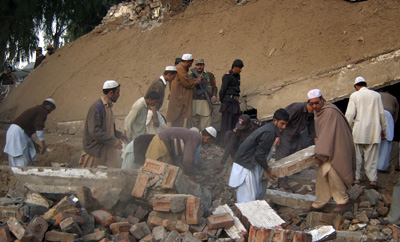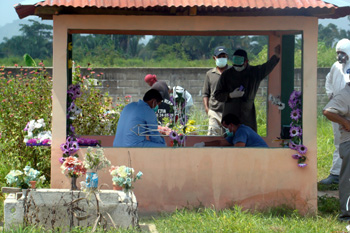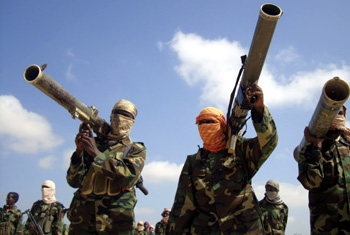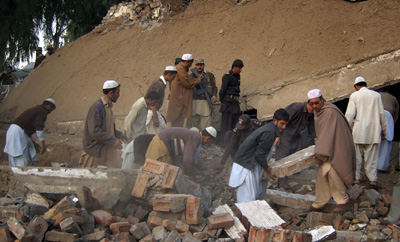At least 42 journalists are killed in 2010 as two trends emerge. Suicide attacks and violent street protests cause an unusually high proportion of deaths. And online journalists are increasingly prominent among the victims. A CPJ special report

Published December 15, 2010
NEW YORK
Amid a rash of suicide attacks, Pakistan became the world’s deadliest country for the press in 2010, with at least eight journalists killed there in connection with their work, constituting a significant portion of the worldwide death toll, the Committee to Protect Journalists said in its year-end analysis.
At least 42 journalists were killed around the world in 2010, with Iraq, Mexico, and Honduras also ranking high for journalism-related fatalities, CPJ’s analysis found. The worldwide toll reflects a notable drop from 2009, when a massacre in the Philippine province of Maguindanao drove the number of work-related deaths to a record 72. CPJ is investigating 28 other deaths in 2010 to determine whether they were work-related.
MORE IN THIS REPORT
• Database of journalists
killed in 2010
• CPJ Blog: Local reporters,
global dangers
• Video report: “In Pursuit
Of Justice”
IN OTHER LANGUAGES
• Français
• Español
• Русский
“The Philippine massacre and the conflict in Iraq pushed the number of journalists killed in recent years to record levels,” said CPJ Executive Director Joel Simon. “The killing of 42 journalists in 2010, while a decline over previous years, is still unacceptably high and reflective of the pervasive violence journalists confront around the world. From Afghanistan to Mexico, Thailand to Russia, the failure of governments to investigate crimes against the press contributes to a climate of impunity that ultimately fuels further violence.”
Internet-based journalists constitute an increasing portion of CPJ’s death toll. At least six journalists who worked primarily online were killed in 2010. Internet journalists rarely appeared in CPJ’s death toll until 2008, when online reporters doing front-line investigative work began to be targeted with violence.
Murder was the leading cause of work-related deaths in 2010, as it has been in past years. But murders composed about 60 percent of deaths in 2010, lower than the rate of 72 percent seen over the past two decades. Deaths in combat-related crossfire and in dangerous assignments such as street protests constituted a larger portion of the 2010 toll than usual. Suicide bombings and crossfire in Pakistan, Afghanistan, Thailand, and Somalia accounted for the unusually high proportion.
Six of the eight fatalities in Pakistan were caused by suicide attacks or crossfire during militant strikes. On successive days in April, Samaa TV lost cameraman Malik Arif to a bombing at a Quetta hospital and correspondent Azamat Ali Bangash to a bomb attack targeting a refugee camp near Orakzai. Suicide attacks were a scourge for the Pakistani press throughout the year. More than two dozen other Pakistani journalists were injured in such attacks in 2010, CPJ research shows.
“The deaths of at least eight journalists in Pakistan are a symptom of the pervasive violence that grips the country, much of it spilling over from neighboring Afghanistan,” said CPJ’s Simon. “For many years, journalists in Pakistan have been murdered by militants and abducted by the government. But with the rise in suicide attacks, the greatest risk is simply covering the news. Journalists must put their lives on the line to cover a political rally, a street demonstration, or virtually any major public event. This is a deeply troubling and frankly untenable situation.”

Raging anti-press violence in Mexico claimed the lives of numerous journalists during the year. CPJ has confirmed that three journalists were killed in direct relation to their work, and it continues to investigate the circumstances surrounding seven other deaths. The victims include Luis Carlos Santiago, a photographer for the Ciudad Juárez newspaper El Diario who was gunned down while on assignment. His murder prompted the paper to publish an extraordinary editorial addressed directly to the drug cartels that control the city. “What do you want from us?” the editorial asked in its headline, noting later that, “You are, at this time, the de facto authorities.”
Worldwide, nearly 90 percent of the victims were local reporters covering issues that affected their communities. Among them was Sardasht Osman, an Iraqi reporter who was seized from a street in Arbil and then murdered after describing alleged corruption in the Kurdistan Regional Government.
Five international journalists were killed in connection with their work. Fabio Polenghi, an Italian freelance photographer, and Hiro Muramoto, a Japanese cameraman for Reuters, were killed in crossfire between Thai security forces and antigovernment protesters. In July, a CPJ investigation concluded that both government troops and demonstrators engaged in recklessness that led to the two deaths. Reuters reported in December that a preliminary government report found that troops may have shot Muramoto.
Belarusian editor Aleh Byabenin was among the online journalists on CPJ’s death toll. Founder of the pro-opposition news website Charter 97, he was found dead in his summer house outside Minsk. Authorities declared the death a suicide without addressing questions about the extensive injuries found on his body, or the absence of a suicide note or motive. Charter 97, whose coverage is critical of the government, has been the target of cyber-attacks and government raids, while its staffers have endured repeated death threats.

CPJ research shows that about 90 percent of journalist murders go unsolved. In Honduras, a CPJ investigation found that authorities had been careless and inattentive in investigating a string of eight journalist murders, at least three of which were work-related. Among the victims was Nahúm Palacios Arteaga, a provocative television anchor who was ambushed by multiple gunmen outside his home. Honduran authorities conducted virtually no investigation in the aftermath, taking no photographs and collecting no evidence at the crime scene. Only after the case drew international attention, months later, did authorities exhume the body to conduct an autopsy.
CPJ has been waging a Global Campaign Against Impunity, focusing on Russia and the Philippines, two nations with high rates of unsolved journalist murders. No work-related murders were reported in Russia in 2010, although one journalist was severely beaten during the year. In September, after meeting with a CPJ delegation, Russian investigators reopened several unsolved journalist murder cases from prior years.
Two journalists were murdered for their work in the Philippines in 2010, continuing a pattern of persistent anti-press violence. In September, prosecutors began trying the first 19 defendants in the Maguindanao case, but a CPJ investigation identified numerous problems that could thwart justice: Witnesses have been intimidated, local police have not cooperated with prosecutors, and forensic evidence has been compromised.
While Pakistan moved to the forefront of dangerous conflict zones, journalists continue to be killed in Iraq, Somalia, and Afghanistan. Deaths in Iraq, after plummeting in 2008, appear to have leveled off amid persistent insecurity. Four Iraqi journalists were killed during the year, the same number as died in 2009. More than 20 journalists had been killed in Iraq in each year from 2004 to 2007, a rate unprecedented in CPJ history.

The death toll dropped in Somalia, where two local journalists were murdered or killed in combat situations. While declining from the nine deaths recorded in 2009, the toll does not likely reflect an improvement in the security situation. At least 59 Somali journalists have fled into exile in recent years, according to CPJ research, and journalists who remain in the country say they must practice extensive self-censorship to survive.
Worldwide, the victims reflect the breadth and diversity of journalism, working in all media and covering topics from war to sports to crime. They include James P. Hunter, a U.S. Army staff sergeant filing stories for military publications, who was killed by an explosion while covering patrols in Afghanistan. Hunter was one of two journalists killed in Afghanistan. Togolese sports reporter Stanislas Ocloo was killed when militants in Angola ambushed a bus carrying his country’s Africa Cup soccer team. And in Brazil, radio reporter Francisco Gomes de Medeiros was shot in front of his home after exposing the activities of drug traffickers.
Here are other trends and details that emerged in CPJ’s analysis:
- Broadcast reporters constituted nearly 40 percent of the victims, the largest single professional category. That’s a departure from long-term CPJ data that show print reporters as the single largest category.
- One journalist died in prison in 2010. Cameroonian editor Germain Cyrille Ngota Ngota was jailed after he and other journalists asked a presidential aide about alleged misuse of state oil company funds. Although an initial death certificate faulted prison officials for neglect, the government denied responsibility.
- Four media support workers were killed worldwide, three of them in a bomb blast that destroyed the Baghdad offices of Al-Arabiya television.
- At least five journalists were reported missing during the year, three in Mexico and one apiece in Sri Lanka and Ukraine.
- Nine freelance journalists were among the 2010 victims, a number consistent with past years.
- Among murder victims, more than 60 percent had reported receiving threats in the weeks before they died. Long-term CPJ research shows that physical attacks are often preceded by phone or electronic threats.
- Other places with media fatalities were: Nigeria, Indonesia, Yemen, Colombia, India, Greece, Lebanon, Uganda, and Rwanda
CPJ began compiling detailed records on all journalist deaths in 1992. CPJ staff members independently investigate and verify the circumstances behind each death. CPJ considers a case work-related only when its staff is reasonably certain that a journalist was killed in direct reprisal for his or her work; in crossfire; or while carrying out a dangerous assignment.
If the motives in a killing are unclear, but it is possible that a journalist died in relation to his or her work, CPJ classifies the case as “unconfirmed” and continues to investigate. CPJ’s list does not include journalists who died from illness or were killed in accidents—such as car or plane crashes—unless the crash was caused by hostile action. Other press organizations using different criteria cite higher numbers of deaths than CPJ.
CPJ’s database of journalists killed for their work in 2010 includes capsule reports on each victim and a statistical analysis. CPJ also maintains a database of all journalists killed since 1992. A final list of journalists killed in 2010 will be released in early January.
